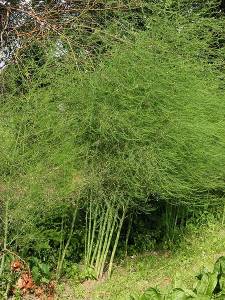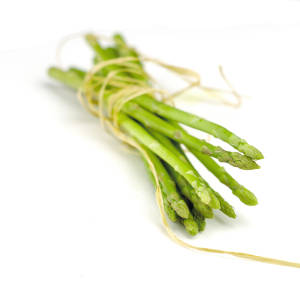Asparagus is a distinct tasting vegetable. Its trademark spears and vibrant green color make it an attractive addition to any vegetable garden. It can live for decades and will do so without much help at all. Asparagus comes in both male and female varieties – females produce berry-like fruit (which is poisonous). The males are the more productive of the two, so if space is limited (and you are growing from seed) you may want to remove the female varieties. Alternatively you can wait until the berries are about to produce seed and sow them for yet more asparagus!
Asparagus grows best in relatively dry and cool places, especially where there is a light ground frost during the winter. It can be difficult to grow asparagus in tropical climates.

Planting Asparagus
Asparagus can be grown from either seed or plant crowns. Planting crowns is recommended as it will save you growing time. Look for crowns that are about a year old for best value for money.
Select a plot that receives plenty of sunlight. Asparagus likes soil with a pH of around 6.5-7. It doesn’t like thin, clay soil at all, so be sure to use plenty of organic compost before sowing if your soil is like this. Asparagus loves organic matter in general, especially manure, so don’t hold back with the poo. You should treat the soil with lime (if the soil is acidic) and organic matter a season or two before planting. Two weeks prior to planting, rake over the soil and add a complete fertilizer in moderate quantities.
If planting from seed, soak them for a couple of days before sowing an inch (2.5cm) deep in drills 18 inches (45cm) apart. As the seedlings reach about 3 inches (7.5cm) tall, thin them so that they are about 6 inches (15cm) apart.
Asparagus can be grown indoors from seed as well. Sow them indoors in pots or trays when the weather is around 13°-16°C. As they grow they will need to hardened off and transplanted once or twice. They benefit of growing from seed is that the gardener can identify female varieties and not transplant them to the permanent bed, thereby creating a higher-yield, all-male crop. The asparagus should be in the permanent plot once the crowns are well developed. Some people are able to plant asparagus seeds as above, leave them for three years and receive an excellent asparagus crop, but this is not a foolproof method.
Plant asparagus crowns in trenches 12 inches (30cm) wide and 8 inches (20cm) deep. In the base of the trench, make a little mound of soil about 4 inches high. Plant the crowns in the mound about 15 inches (40cm) apart by spreading out the roots and cover them with 2 inches (5cm) of soil.
Growing Asparagus
As asparagus crowns grow in the trench, gradually cover them with more soil. Eventually the trench will be filled with soil.
Keep the bed weed free and water during dry weather. If the bed is exposed to harsh weather it may be a good idea to support or protect the foliage from strong winds to prevent damage to the crown. Mulching helps keep weeds down and aids moisture but doesn’t do a great deal of good for the asparagus itself. After two years or so the asparagus will be fully mature with a good root system and will hardly need any attention at all except for the occasional water during summer.
Harvesting Asparagus
The hardest bit about growing asparagus is not harvesting them until 3 years after planting (2 if growing from crowns). It is harvested by cutting the asparagus at or just below ground level using a sharp knife. Harvesting time is around spring to early summer the world over.
Threats to Asparagus
Asparagus beetles are the biggest threat to asparagus. They look dark and metallic with yellow/white spots on their back. They can be controlled by manual removal or using an insecticide spray.

